- 07736 104738
- sam@medicalmassagelady.com
- Mon - Sat, 8:00 - 18:30
WHAT IS CELLULITE?
Cellulite, otherwise known as gynoid lipodystrophy, is used to describe an area of skin which has a dimpled appearance. It is usually seen in more fatty areas eg. the hips, buttocks, and thighs, but can also occur on the lower abdomen and upper arms, affecting 80 to 90 percent of adult women. Reducing body fat and increasing muscle mass may help to reduce the appearance of cellulite, but while more common in those who are overweight, it can also affect very lean people.
The skin consists of 3 layers called the epidermis, dermis and hypodermis (subcutaneous fat layer).
The subcutaneous fat sits just below a layer of connective tissue, mostly made of collagen, and it stores energy, provides protection and insulation, and attaches the upper layers of skin to muscle and fascia. When the fat protrudes through the collagen, due to the breakdown of fibrous bands that anchor the skin to muscles, it will cause a dimpled appearance.
CAUSES OF CELLULITE
We are all susceptible to developing cellulite, but some are more prone to it than others.
- Gender and anatomy - The collagen fibres in men run at a 45-degree angle, forming a criss-crossed pattern which holds down fat cells effectively, making it more difficult for the subcutaneous fat to protrude. Women, however, have vertical bands of connective tissue, running perpendicular to the skin, which are more likely to allow fat cells to push through. Women with cellulite also tend to have higher amounts of fibrous septae, (thick bands of connective tissue) that pull the skin down, further increasing the appearance of cellulite.
- Hormones - Oestrogen in particular plays a role in the formation of fat cells and cellulite, explaining why women are more prone to cellulite, and why it sometimes begins after puberty and worsens during pregnancy. Higher oestrogen levels may also affect the severity of the cellulite as they are linked to fat storage in the thighs and hips. Androgen deficiency and oestrogen therapy eg. HRT are also linked with greater incidence of cellulite.
- Age - As we age, the skin becomes less elastic and connective tissue bands naturally weaken and become thinner, potentially making it easier for the fat to protrude through it and increasing the appearance of cellulite. However, cellulite can occur any time after puberty.
- Genetics - Fat distribution, skin elasticity, and other factors influencing cellulite are determined by genetics, so if a close relative has it, chances are you will too, hence why cellulite is difficult to get rid of or prevent.
- Diet - Research has shown that a high-fat, high-salt, high-preservative diet can bring about metabolic disorders which may accelerate cellulite.
- Lifestyle - Certain lifestyle factors, eg. Low exercise levels , smoking or increased alcohol intake, can affect the circulation, inflammation, and fat cell formation and distribution. A highly active lifestyle, balanced nutrition, an anti-inflammatory diet and good hydration may improve the cellulite. A diet lacking antioxidant-rich plant foods and water can also cause the skin to lose collagen and appear dehydrated, making cellulite more noticeable over time.
- Inflammation - Inflammation may have an effect on connective tissue which, in turn, may lead to cellulite.
- Poor lymphatic drainage
- Poor circulation in the legs
- Pregnancy - Some women develop stomach cellulite during and after pregnancy due to increased weight gain in a short amount of time, as well as high oestrogen levels.
- Body composition - Research has suggested that higher body fat percentage can increase the appearance of cellulite, possibly due to excess body fat being pushed through the connective tissue. Extreme weight loss and weight gain can cause the skin to become stretched, which can lead to an accumulation of larger fat cells. While increasing lean muscle through strength training may reduce the appearance of cellulite, having cellulite doesn’t automatically mean you have excess body fat.
DOES MASSAGE FOR CELLULITE WORK?
Massage won’t get rid of cellulite but it may improve the appearance by:-
- draining excess body fluid (through lymphatic drainage)
- redistributing fat cells
- improving circulation and removing toxins
- plumping up skin and improving skin tone
but the results tend to be short term so repeat treatments are required.
RESEARCH
There is no substantial evidence to show that massage will reduce cellulite, but many studies do show that there can be a temporary improvement in the appearance, hence massage needs to be a regular therapy, and will also be more effective when combined with exercise and supplementation with collagen peptides.
- dry cupping can promote drainage of fluid, toxins, and other chemical waste products, which may improve the appearance of cellulite
- lymphatic drainage massage can help the lymphatic system drain fluid, debris, and toxins
- deep tissue and IASTM (instrument assisted soft tissue mobilisation) can improve circulation, break down adhesions and nodules, and apply pressure to the soft tissues that connect muscle to skin
- aromatherapy can work on balancing the hormones, boosting circulation and nourishing the skin
CONSIDERATIONS
If you’d like to try massage to treat cellulite, it is important to understand its limitations ie. It will not get rid of the cellulite but it can improve the appearance in the short term. To reduce the dimpled, uneven skin texture in the long term, repeat maintenance treatments will be required.




